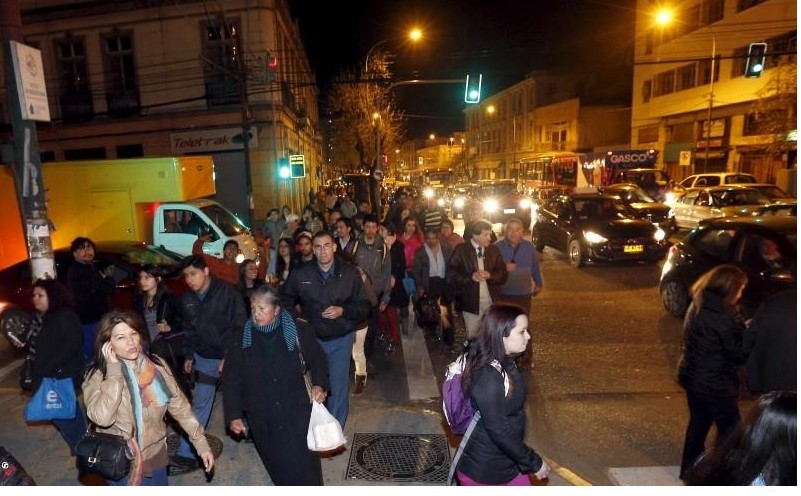SANTIAGO, (Reuters) – Strong aftershocks rippled through Chile today after a magnitude 8.3 earthquake that killed at least eight people and slammed powerful waves into coastal towns, forcing more than a million people from their homes.
After the powerful quake hit last evening, the government ordered evacuations from coastal areas to avoid a repeat of a quake disaster in 2010 when authorities were slow to warn of a tsunami that killed hundreds.
As the risk subsided, the government lifted its tsunami warning this morning.
The quake and heavy waves afterward caused flooding in coastal towns, damaged buildings and knocked out power in the worst hit areas of central Chile and shook buildings in the capital city of Santiago about 280 km (175 miles) to the south.
The port of Coquimbo suffered major damage in the quake, which was the strongest in the world this year, Interior Minister Jorge Burgos told a news conference.
President Michelle Bachelet said she planned to travel to the areas worst affected by the quake, the biggest to hit the country since 2010.
“Once again we’re having to deal with another harsh blow from nature,” she said in a televised statement.
Chile is the world’s top copper producer and operations were suspended at two big copper mines.
Copper prices on the London Metal Exchange rose to two-month highs in early Asian trading on worries about supply disruptions.
The quake was felt as far away as Buenos Aires in Argentina.
“It’s been awful. We ran out of the house with our grandchildren and now we are on a hill hoping it will be over soon,” said Maria Angelica Leiva from the coastal town of Navidad.
“It is all very dark, and we just hope the sea hasn’t reached our house,” she said.
Tsunami advisories were issued for parts of South America, Hawaii, California and French Polynesia, although waves were generally expected to be small. As far away as New Zealand, authorities warned of “unusually strong currents” and urged residents in eastern coastal areas to stay out of the water and off beaches.
AFTERSHOCKS FELT
Dozens of strong aftershocks continued to rattle central Chile, a largely agricultural region south of the mining belt, today.
A 26-year-old woman was killed by a collapsing wall in Illapel, near the quake epicenter. Another person died from a heart attack in Santiago, according to media reports.
Most buildings in Illapel had stayed standing, residents said. Quake-prone Chile has strict building regulations that limit potential damage, so newer buildings are able to withstand even strong quakes. Many homes in Illapel and surrounding areas are simple, adobe houses and are more prone to damage.
The brunt of the damage was borne by coastal areas where houses and fishing-boats were smashed by waves. The coastal town of Coquimbo was hit by waves of up to 4.5 meters (15 feet) after the earthquake, Chile’s navy said.
“We’re going through a really grave situation with the tsunami. We have residential neighborhoods that have flooded. The ocean has reached the downtown area,” said Coquimbo Mayor Cristian Galleguillos.
Residents reported looting of evacuated houses in Los Vilos, another seaside town, its mayor said.
Chile is due to celebrate its national holiday on Friday, but roads were cut off and public transport canceled between Santiago and the north, local media reported.
The quake is the latest natural disaster to roil mining in Chile, which accounts for a third of global copper output. Northern Chile was hit by severe floods earlier this year, while a volcanic eruption caused problems for residents in the south.
State copper miner Codelco said it had suspended mining operations at its Andina mine but had restarted operations at its Ventanas smelter after evacuating workers there. Antofagasta said it had halted operations at its Los Pelambres copper mine and would wait until daybreak to assess damage.
Chile runs along a highly seismic and volcanic zone where tectonic plates meet and often experiences earthquakes. In 2014, an 8.2-magnitude quake struck near the northern city of Iquique. In 2010 an 8.8-magnitude earthquake in central-southern Chile triggered a massive tsunami, and more than 500 people were killed.
In the hours after that quake, President Bachelet and other government officials misjudged the extent of damage and declined offers of international aid. That delayed the flow of assistance to disaster areas, leaving many survivors feeling they had been abandoned by the government.
Bachelet’s government was also slow to prevent looting following the quake. Its failings hit her high approval ratings at the end of her presidential term, although she remained popular and was elected again in 2013.









